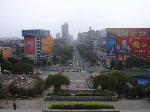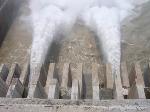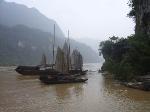- Getting around Lijiang. Dont stay in the Old Towns more than 2 days, there is nothing to do. KRISS Oct 9, 2013 05:46
- 2013 Beijing Temple Fair BENNYLAU Feb 26, 2013 03:29
- Malaysian traveling from KUL - LAX vis Shanghai PVG ZATI_DY Jan 3, 2013 20:15
Gorgeous gorges and a damn dam?
- Views: 8623
- |Vote: 4 1
- |Add to Favorites
- |Recommend to Friends
A tale of two mountains
One of the most popular folk tales in China tells about a ninety year old man named Yugong who inconveniently lives between two mountains. One day he decides to move the mountains and aided by his children and grandchildren, starts leveling them. It takes them a full year to travel back and forth to the nearest sea to dump the rock and dirt. One day Yugong meets an even older man who says to him "Aren't you foolish! You are old now and with whatever remains of your waning strength you won't be able to even remove a corner of the mountain" Yugong sighed and replied "You don't understand anything! After I die, there will be my children, grandchildren and great grandchildren. My descendants will go on forever, but those mountains certainly won't grow any taller!"
I was reminded of this story when looking at the Three Gorges Dam from a nearby observation platform. Human power has greatly increased since Yugong's time. In our era we don't require endless generations of descendants to accomplish a great task like leveling mountains. Only 12 years were enough to build a gigantic dam amidst steep gorges and right in the middle of the world's 2nd longest river.
But let us start at the beginning.
Yichang City
A trip to the famous Three Gorges and (in)famous Three Gorges Dam usually starts in either Chonqqing(重庆)on the one end of the gorges or Yichang(宜昌)at the other end. Since I didn't have enough time for a multi-day cruise down the Yangtze River and was especially keen on seeing the dam, I traveled to Yichang in Hubei province, since this place is very near to the dam and lies at the end of Xiling Gorge (西陵峡), the biggest one of the entire Gorges area.
After an extremely tiring 16 hour train ride (hard seat, no air-conditioning, crowded, hot, dirty) I arrived in the medium-sized city of Yichang. The train station lies on a broad hill ridge that divides the city into a northern and a southern quarter; therefore, when you leave the station you immediately get a nice view of the modern downtown area.
Yichang somehow reminded me of Shanghai, although this calm prefecture-level city of course offers the travelers a very different experience then the bustling metropolis at the far end of the Yangtze. Still, the climate, the fresh feel of the downtown area with its futuristic high-rise and lavish parks, and the green boardwalks along the Yangtze River just gave the city a 'touch' of Shanghai, as though some of the that city's sparkle had somehow traveled upstream and nestled itself in Yichang.
I found Yichang a very pleasant city, although it lacks any (historic) sights of particular interest. I spend a relaxed day wandering along the river boulevards and trough the neighborhoods adjacent to the Yangtze embankment. To my surprise there were many churches and some smaller areas even featured numerous (by now very dilapidated) houses and villa's built in European architecture. I guess this was another reason why the city reminded me of Shanghai.
Since it is a river city, many local dishes contain fish or shrimp and I especially enjoyed Yichang's typical breakfast menu of re gan mian (热干面) although this oily peanut-noodle dish is quite 'heavy' for the empty morning stomach.
Due to it's location near dam and gorges, Yichang is a popular tourist destination, which is clearly demonstrated by the sheer number of travel agencies you'll find in the city's streets. Of course arranging your trip on the spot in one at of these agencies is a lot cheaper then booking things weeks ahead, especially if you feel like bargaining down a bit.
Cry me a (Yangtze) river
I decided to make two separate day trips. One the Three Gorges Dam and one full-day boating trip down the Yangtze. First up was the dam.
The Three Gorges Dam is without a doubt one of the most contested (and condemned!) building projects in the world. Of course the discussion principally took place in the West, given that within China, the Chinese government largely restricts this kind of debate. Although they have responded to many of the environmental, social, cultural objections made internationally.
Of course a project of this size (the Dam is 185m high, and more then 2300 meters long) can not go without huge impacts on its (wide) surroundings. Enough has been said about the effects of the rising water level, which caused more than 1.1 million people to be involuntarily displaced and inundated many special cultural and archeological sites. And we're not even talking about the effect on plant and animal life within and along the river. Yet, I truly believe the benefits of the dam are too, both many and important!
I for one, couldn't help being utterly fascinated by this giant structure, which is (whatever you may think of the negative effects) a true marvel of human knowledge and technological aptitude. Just think of it; you have one of the world's most mighty rivers, flowing quite speedily trough a number of inhospitable gorges; and then placing a dam right in the middle of all this. It sounds completely impossible, but with the combined efforts of thousands of skillful people; they actually pulled it of!
Getting in a comfortable touring bus at Yichang, we drove out of this city and soon entered an express way to the dam, which winded itself through the attractive mountains of the Xiling gorge and occasionally provided some nice vistas on the Yangtze. After about an hour, we arrived at the entrance of the Dam city; a town that was especially built for al the employees working on the dam. The day tour I booked was packed; first stop was a panorama point on a small peak not far from the dam. Called the 'Earthen Jar' it provided a spectacular bird's eye view of the enormous dam and on one of the equally huge ship locks. Next we explored one of these ship locks that is constructed on a place, where a big mountain once flanked the river.
The bus ride across the dam itself was quite exciting, especially when we made a short stop in the middle of the massive wall of concrete and could look over the edge of it. Right underneath me the Yangtze water was pushed out of one of the dam holes with such an enormous force that the vibration of it, made my entire legs shake, even though I was standing more than 160 concrete-filled meters above the water outlet. (And don't go saying those shaking legs were caused by vertigo; honestly, it was the power of the water only ;))
Next the tour bus took us to a park down the river, which was a kind of thematic garden about the construction process of the Three Gorges Dam. There we're exhibitions, a small movie theatre and some outdoor pavilions. Like I said before; what a challenging project it was in terms of human inventiveness!
The final stop of the day took us to a small aquarium, showcasing the aquatic life of the Yangtze River. Although the place was somewhat outdated and tacky, it was still interesting to see the special kinds of fish that populate the long river. The highlight undoubtedly was an enormous 500kg Chinese sturgeon.
The final display of the aquarium was about the extinct fish of the Yangtze. It was here I first learned about the beautiful and unique kind of freshwater dolphin that not so long ago populated the river's waters. It wasn't until 2006 that this graceful animal named Baiji or Yangtze River Dolphin was -after a thorough scientific search expedition along the river- officially declared extinct. A sinister reminder was formed by a young Baiji specimen being displayed in filthy ethanolic conservation fluid. And yet another unique Yangtze marine animal species is close to becoming history; of the Yangtze finless porpoise there are only about 700 left, when last counted in 2006.
Perhaps the construction of the Three Gorges Dam has played only a small part in the downfall of many species of the Yangtze River's flora and fauna. Yet, the big contributors are of course the enormous (and ever growing) numbers of factories on the banks of the Yangtze, which pollute the river more every day, with their waste products. Many things can be said about the Dam, but the thing by itself doesn't pollute the river. In fact; it provides a gigantic and badly needed amount of clean energy.
I left the aquarium feeling kind of gloomy. All those factories and their pollution, the disappearance of an elegant creature like the Baiji; I guess those things are the bitter sacrifices of economic progress along China's most important river.
Gently down the stream
In China gloom never last long though. Especially when a sunny new day will take you on a boat trip through the Xiling gorge, the final and longest of the three gorges. Very early in the morning I am again picked up in Yichang by a bus of the travel company and we ride upstream for a few hours. When we arrive at a small riverfront town an old ramshackle riverboat awaits us. Although the small ship really didn't seem like much from the outside, the inside was clean and cozy with its interior completely made out of bamboo. The upper sundeck also had comfortable seating, but these were only available for those who made the skipper happy by giving him a note of 50RMB.
Not much later we were lazily sailing down the river, amidst the heavy river traffic mostly consisting of big containerships as well as some large cruise ships. The mountains lining the river have the most peculiar shapes and sizes and can really be considered eye candy. Particularly at places where picturesque villages are quietly lying at the foot of shapely peaks. The abundant vegetation on the hillsides is so green and flourishing, that it sometimes seems you're right in the middle of the Amazone.
About halfway trough our relaxed trip, the boat made a stop at a traditional riverside village. Although this village of course was especially built for tourists and thus very new, I still found it a wonderful demonstration of what traditional life at the banks of the Yangtze must have looked like many years ago. The old fishing boats floating on the water, with the steep walls of the gorge on the background made for an almost iconic Chinese image [see picture]
After many hours of sailing trough the gorge, the high mountain peaks gradually gave way to a much more open landscape: we were nearing Yichang again. That we were approaching the city was clearly marked by all the junk yards, countless rusty ship carcasses, sewerage pipes spilling murky fluids into the river and old factories surrounding us. An anticlimactic end of a relaxing and beautiful trip trough the natural splendor of the Xiling gorge.
Once again I think of the story of the old man Yugong who wanted to move the mountains. He needed countless generations to accomplish his goal, but in these dynamic high-tech times the human race seems capable of doing almost anything within just a quarter of a lifetime. We can do magnificent things, but unfortunately also alter our surroundings in destructive ways. A trip to the Yangtze, the Three Gorges and the Dam ultimately results in these kinds of reflections, because this is a place where the human modification of their environment can be noticed very, very evidently.
As we disembark the boat, my fellow travelers and I talk about this. Everybody is impressed by the contrast between the magic beauty and outright ugliness of what they have seen. And as we step on the Yichang's streets and make our way to the city center, the water of the Yangtze quietly flows along behind us, as it has always done, bound for the East China Sea.






 Copyright © 1998-2025 All rights reserved.
Copyright © 1998-2025 All rights reserved.